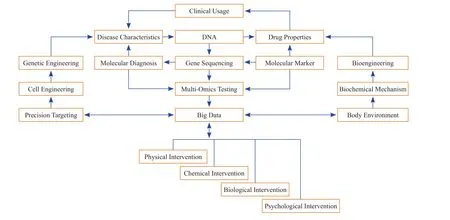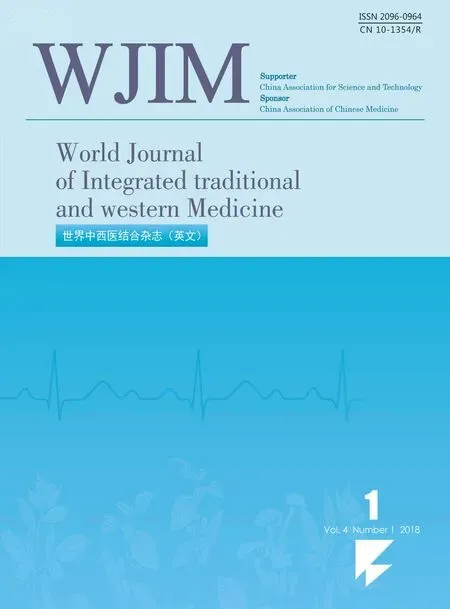A Life System Tuning Model
Hua Ziang (華子昂), Wan Junxing (萬君興), Zhu Tian (竹添), Sun Ning (孫寧),Yu Jiyun (于繼云), and Chen Changfeng (陳長風)
Beijing Huaniu Century Biotechnology Institute, Beijing 102300, China
ABSTRACT OBJECTIVE: To establish a "life system tuning model", which will provide theoretical and methodological basis to solve various medical problems such as the diagnosis and treatment of complex diseases. METHODS: First of all, by using the approaches of systems biology, bioinformatics, and systems engineering, we set DNA as the center of this model, which severs as a bridge linking the characteristics of a disease with the pharmacological properties of the treating medicine. Secondly, the model shows how to employ molecular markers to dissect the pharmacological property of the drug, and the relation between the pharmacological property of the drug and its clinical administration.Also demonstrates how to discover therapeutic targets and to develop targeted medicine based on the biochemical features of the patients, which reflect their physiological and pathological body environment. Finally, the model uses systems biology data to determine molecular mechanisms underlying the disease and subtype, then employ precision methods to adjust the function of some master molecules. RESULTS: Based on the genetic information, this model integrates the diagnostic information from Western medicine and the disease pattern classi fication of TCM that is generated from the four diagnostic methods of "inspection, auscultation and olfaction, inquiry and pulse-taking and palpation". This model also integrates various disease intervention approaches including physical methods, chemical methods, and psychological methods. CONCLUSIONS: The establishment of this model provides a basis for personalized treatment of disease using various methods, for the protection and exploration of various natural resources used in TCM, and for the standardization of TCM.
KEY WORDS: Life Model; Systems Biology; DNA; TCM
In spite of the great achievement of life sciences,many complex diseases, such as cancer and diabetes,still remain unsolved challenges to human health. Since complex diseases are often systemic diseases with various abnormalities occurred in the patient body, it is reasonable to treat such diseases at different levels, targeting factors are causal for their initiation and progression, and the deterioration of the entire body environment. Traditional Chinese medicine (TCM) considers the human body as a small universe with the same rule that governs the outside world. Thus, TCM treats the patients in a holistic way,and such an approach is valuable in treating complex diseases such as cancer and diabetes.
Theoretically and methodologically, TCM is based on "Xiang-thinking", and it has evolved into a system of experience-based "Xiang-medicine". In contrast, Western medicine is a science-based system, and has made great achievements in revealing the anatomical and functional mechanisms of the life.
In order to integrate the anatomical and functional mechanisms revealed by Western medicine with the Xiang-thinking-based TCM, and to modernize TCM into an all-round medical system, great efforts have been made in the past century. With the help of modern life sciences and technology, once the molecular basis for TCM is revealed, a modern international standard for the principle-method-recipe-medicine system of TCM will be established. Integrated with Western medicine, the rebirth of TCM will exert profoundly impact on the future medical systems.
Through many years of systematic studies using the approaches of systems biology, bioinformatics, and systems engineering, we have established a "life system tuning model", which will provide theoretical and methodological basis to solve various medical problems such as the diagnosis and treatment of complex diseases.
At the center of this model is DNA, the genetic information carrier, which is commonly found in almost all living lives, including animals, plants and microbes. Therefore, DNA severs as a bridge linking the characteristics of a disease with the pharmacological properties of the treating medicine. We use genetic testing and a multi-omics mutual validation platform to precisely diagnose the disease, and thus determine its characteristics. In terms of the pharmacological properties of the medicine, based on the metabolic mechanisms and the using of molecular markers, we match the pharmacological properties of the medicine to the characteristics of the disease, and mathematically determine the efficacy range of medicine to its major targets. Such an approach is especially important to standardize the prescription and production of Chinese medicine, since it will overcome the problems of content variations of the bioactive ingredients in raw materials grown under different conditions, in different areas and in different climates.
On the right side of the Figure 5, the path of "molecular markers-drug property" shows how to employ molecular markers to dissect the pharmacological property of the drug,and the relationship between the pharmacological property of the drug and its clinical administration. The path of "body environment-biochemical mechanism-bioengineering"demonstrates how to discover therapeutic targets and to develop targeted medicine based on the biochemical features of the patients, which reflect their physiological and pathological body environment.
In practice, we first screen bioactive ingredients from Chinese medicine, and look for the therapeutic effects, which are similar to those of Western medicine.Secondly, we perform cluster and correlation analysis on the chemical footprint and DNA footprint of Chinese medicine and the traditional classification of their therapeutic functions. Lastly, we establish the pharmacological mechanisms for the core ingredients of Chinese medicine based on the known function of their counterparts of western medicine. Once the pharmacological mechanisms are determined, because the core ingredients determine the pharmacological properties of Chinese medicine, we can scientifically re-define the traditional annotation about their therapeutic effects.Diagnosis and prescription of TCM is based on disease pattern classification, and thus the pharmacological effect of a formulation is often illustrated as its function on a specific disease pattern, such as "heat-clearing and detoxifying", and "promoting circulation and removing stasis". Such a qualitative description, however, is rather simple and vogue, and thus hard to standardize the prescription and production. In our model, we overcome such problems through molecular markers by a standardized description of the pharmacological properties of Chinese medicine.
In this model, the body environment refers to as the systemic physiochemical characteristics, such as body pH, temperature, heart rates, and osmotic pressure;the biochemical mechanisms refer to the mechanisms underlying the systemic physiochemical characteristics.For instance, the sodium potassium pump acts to regulate intracellular osmotic pressure and to regulate water content of the tissues; alkaloids regulate the pH value of the body. As an integrated part of the model,bioengineering is employed to achieve two goals:modifying medical plants and animals using molecular breeding, and thus enhancing their production of medical ingredients; achieving biosynthesis of medical compounds through molecular engineering.
On the left side of the Figure 5, the path of"molecular diagnosis-disease characteristics" illustrates that we use genomic information to determine the genetic background and disease subtypes; we use transcriptomics and proteomics information to determine the molecular mechanisms underlying the disease; we use metabolomics and clinical biochemistry information to determine the stage, subtype, and severity of the disease. The path of"precision targeting-cell engineering-genetic engineering"shows that we use a multi-testing platform to analyze various parameters of the patient including genetic,protein, cellular, metabolic, and body environment information. These tests determine the targets for precision treatment by physical, chemical, biological,or psychological interventions. We use cell engineering approaches to modulate multi-signal pathways that are essential for the initiation and progression of the disease,while we employ genetic engineering methods to adjust the function of some master molecules.

Figure 5. A life system tuning model
Using systems biology approaches, we perform cluster and correlation analysis on disease pattern classification of TCM (such as the hyper-activation of liver yang, and the deficiency of Qi and blood), and metabolomics, clinical physiological and imaging diagnostic information from Western medicine, and establish a mathematic algorithm relationship between the disease pattern classification of TCM and modern omics data.
Based on the genetic information, this model integrates the diagnostic information (such as the genetics, protein, cellular, metabolic, physiological,biochemical and imaging information) from Western medicine and the disease pattern classification of TCM(such as the failure of the spleen to govern the blood,the stagnation of vital Qi, and abdominal discomfort and fullness) that is generated from the four diagnostic methods of "inspection, auscultation and olfaction,inquiry and pulse-taking and palpation". This model also integrates various disease intervention approaches including physical methods (physical excises, ultrasonic,electronic, magnetic, heat, and light), chemical methods(diets, drugs, and food supplements), biological methods(bacteria and virus), and psychological methods.
The establishment of this model provides a basis for personalized treatment of disease using various methods,for the protection and exploration of various natural resources used in TCM, and for the standardization of TCM. With the fast advancement and integration of biotechnology, biosciences, modern medicine, internet information technology, and artificial intelligence, this model serves to guide the development of molecular Chinese medicine industries, and the technological integration of the biosensors (touch, smell, taste, and vision sensors), electromagnetic frequency conversion and scanning, virtual reality, augmented reality, and systematic constellation, manufacturing mobile and remote diagnostic equipment, and modern diagnostic and treatment robotic systems for Chinese medicine.
 World Journal of Integrated Traditional and Western Medicine2018年1期
World Journal of Integrated Traditional and Western Medicine2018年1期
- World Journal of Integrated Traditional and Western Medicine的其它文章
- A Systematic Review and Meta-Analysis of Herb-Partitioned Moxibustion in the Treatment of Primary Dysmenorrhea
- Probing the Definition of Yin and Yang in Our Body
- Analysis on the Pharmacists Intervention Results of the Problems from 2000 Prescriptions of Chinese Herbal Pieces
- Systematic Review and Meta-Analysis of Randomized Controlled Trials of Xianling Gubao Capsule as Adjuvant Treatment of Osteoporotic Fracture
- New Year's Message
- Therapeutic Effects of "Soothing the Liver Method" on Stress-related Non-alcoholic Fatty Liver on Neuroendocrine-metabolic Level
